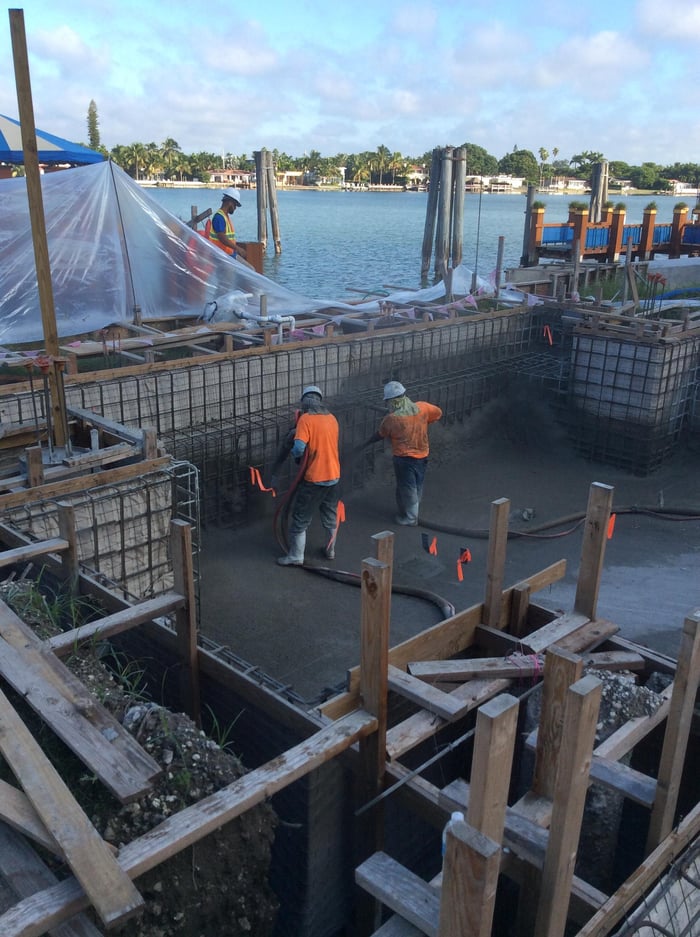It’s a day of monumental importance — the most critical part of building a swimming pool that will determine its quality, safety, integrity, and longevity. There’s a lot riding on a concrete day: when concrete is applied to create the shell of your swimming pool. In the pool industry, the process involves a material called shotcrete (a wet or dry mix) that is applied using a pneumatic hose. Proper preparation, an exact concrete mix, appropriate velocity, and skilled application technique must be employed during the concrete process to achieve a high-quality swimming pool.
The reality is, this concrete pool “base” will hold tons of water. It’s not like any old cement job. And, there is so much that can go wrong on “concrete day” that a quality pool provider should be on site to manage the process, from beginning to end.
From concrete application techniques to curing and inspection, here are some factors that determine the success of the pool concrete process.
shotcrete or gunite for your swimming pool?
 In the swimming pool industry, wet or dry shotcrete are both used and equally suited for the job. Without a doubt, wet and dry shotcrete mixes are the best methods for concrete applications, according to Drakeley Industries, an international firm that provides a review of all shotcrete applications, along with certification. When failed concrete projects evolve into court cases, Drakeley Industries is an expert witness and consultant.
In the swimming pool industry, wet or dry shotcrete are both used and equally suited for the job. Without a doubt, wet and dry shotcrete mixes are the best methods for concrete applications, according to Drakeley Industries, an international firm that provides a review of all shotcrete applications, along with certification. When failed concrete projects evolve into court cases, Drakeley Industries is an expert witness and consultant.
But why not bring in an industry expert before concrete installation? Reef Pool Builders partners with Drakeley to help create concrete placement plans for large pool installation projects. As a team, we collaborate to ensure proper staging, supervision, and inspection. Some pool projects can call for a dozen or more concrete trucks and crews. To implement a seamless concrete day, there must be a well-defined strategy underwritten by a leading expert. Our clients appreciate that we are bringing in the “big guns” to plan for concrete installation so they can rest assured that the job will be done right.
Wet Or Dry—What’s the Difference?
Shotcrete is concrete that is applied through a pneumatic hose. In the wet form, it arrives on the poolside in a concrete mixer and is pneumatically applied to the pool frame. Dry shotcrete, commonly referred to as gunite, is a mixture of cement and sand. As dry gunite passes through the pneumatic hose, water is added at the hose nozzle point. The mixture is then shot at a 90-degree angle. (This positioning is critical to ensure structural integrity.)
Why Gunite? At Reef Pool Builders, we have moved toward gunite because of its durability and the integrity of gunite applicators. Again, both wet and dry shotcrete is the gold standard for swimming pool installation. However, we believe in only hiring certified gunite applicators. (In South Florida, there are no certified wet shotcrete applicators, which influenced our decision toward using gunite instead.)

Why Single-Source Providers? We always work with gunite professionals who supply the materials and apply the product. Some contractors only supply cement, and then you must hire the applicator. With two separate companies involved, there can be some finger-pointing if there’s a problem. The applicator blames the cement mix provider for a faulty mix; the gunite or shotcrete provider says the material is fine but the applicator is not using the proper technique. With a certified gunite contractor that supplies and applies the product, you get single-source accountability and assurance that the applicator is trained and experienced.
preparing for the concrete shoot
Your swimming pool provider probably subcontracts the cement portion of the project, but the company should be on site overseeing this critical step in the pool installation process. Before the concrete “shoot,” the interior structure must be verified and built to spec, and the substrate must be dry and free of debris. Preparations should be inspected and verified prior to the shoot.
Key preparation methods that Drakeley Industries inspects for include:
- An excavation site that is free of standing water and debris
- Steel that is raised 2 to 3 inches above the floor and away from the sides. The American Concrete Institute specifies a minimum of 2 inches of coverage around any concrete encapsulated reinforcement.
- Freestanding walls with proper support mechanisms to avoid vibration
- Firmly mounted plumbing lines
managing quality: 3 concrete issues to avoid
Concrete application is an art and science. You must have the proper equipment—specifically, compressors that deliver 250 CFM minimum for wet and 700 CFM minimum for gunite. Also, equipment setup is crucial. All equipment should be as close to the shooting site (pool) as possible. As for technique, the distance between the nozzle and substrate should be no farther than 6 feet and always at a 90-degree angle.
At Reef Pool Builders, we provide 100% supervision of every part of pool construction. On a concrete day, our field crew is on hand to assist and ensure that the application meets all specifications. We’re checking for correct elevations and making sure that pool steps are at the proper height. We’re also ensuring the cleanup of all “rebound,” which is cement material that falls to the pool floor during application. Rebound must immediately be removed to avoid honeycombing and hollow spots.
Overall, here are 3 key issues we watch for when concrete (in the form of gunite) is applied to the pool interior.
- Honeycombing: Course, stony patches on the cement surface are referred to as honeycombing. It can be caused by insufficient fine material in the mix. We find that gunite tends to cause less honeycombing. Honeycombs indicate pockets where water can get through, which can ultimately cause leaking.
- Cracking: Concrete naturally cracks as it dries, so it must be kept moist during the curing process. Most concrete is 100% cured to its maximum psi in 30 days, but by the third day of curing concrete reaches the state minimum psi. Our project specifications call for 5000 psi and a 7-day curing test period for the highest-quality concrete application.
During those first three days of curing, concrete must be kept damp. We spray it down several times daily or cover the surface with a damp sheath cloth. It is critical to lock in moisture to avoid all cracking during this vulnerable time.
- Hollow spots: After curing, we check the pool floor for hollow spots. Usually, this is done by dragging a chain along the pool floor. Its sound will indicate hollow areas. If hollowness is detected, those spots are chipped out, cleaned, waterproofed, and repacked with hydraulic cement. This is important because hollow spots (sometimes called “pop-ups”) can weaken with the weight of water and crack, so you’ll risk leaks.

hire a trusted pool provider to oversee concrete pool construction
Installing the concrete shell of a swimming pool requires quality gunite or shotcrete material and technical expertise. It’s not something that any general contractor can handle. (We’ve heard, “I can build a house, so I can lay concrete for a pool.” But here’s the thing: Your house does not support tons of water!)
At Reef Pool Builders, we only partner with certified gunite applicators for all of our pool construction projects. Gunite surfaces undergo testing of materials for compressive strength. Of critical importance, Reef Pool Builders is on-site the entire time to ensure quality. One wrong move could compromise the quality of your swimming pool. The concrete is the foundation of your pool. Make sure you align yourself with a swimming pool provider with the experience to execute the job.
Watch this video of Reef Pool Builders on the job.
Let’s talk more about what you should look for in a South Florida pool provider. Call us any time at (305) 901-1505, or fill out this simple contact form and we’ll get in touch with you.


